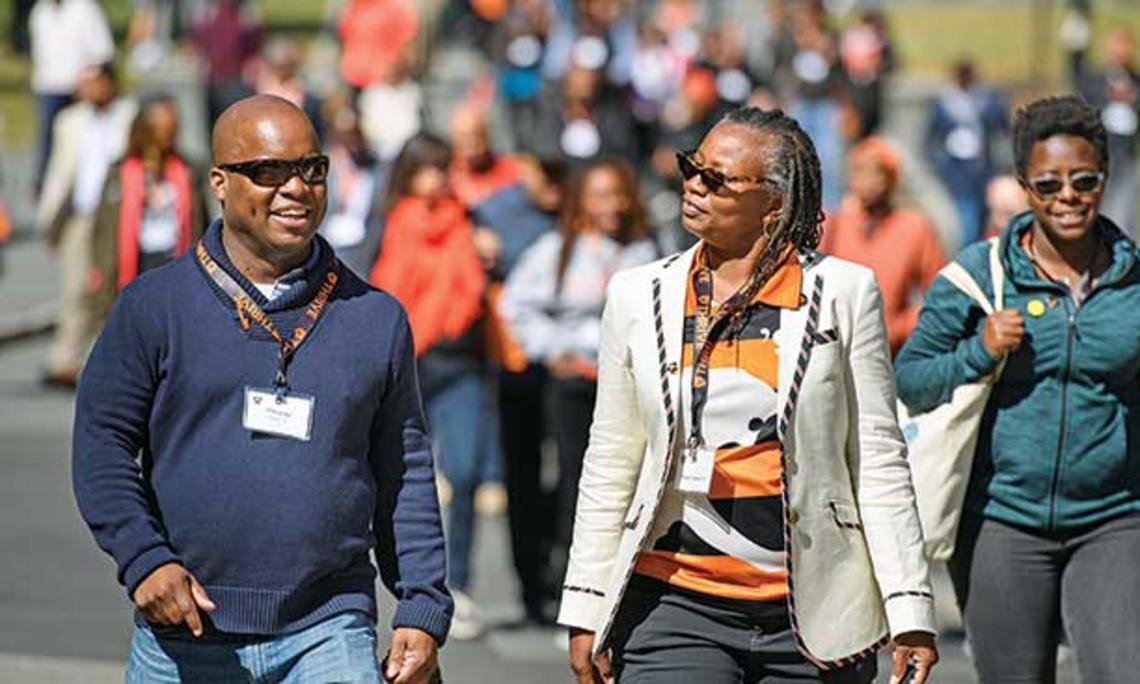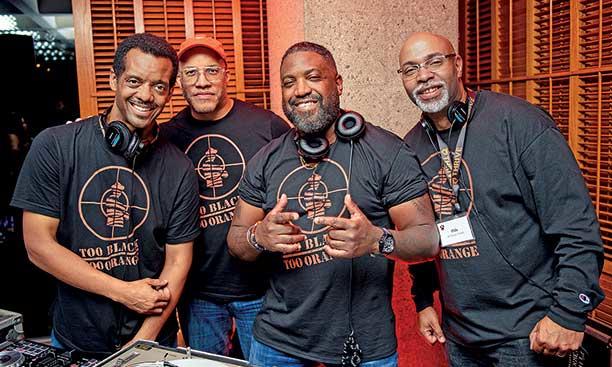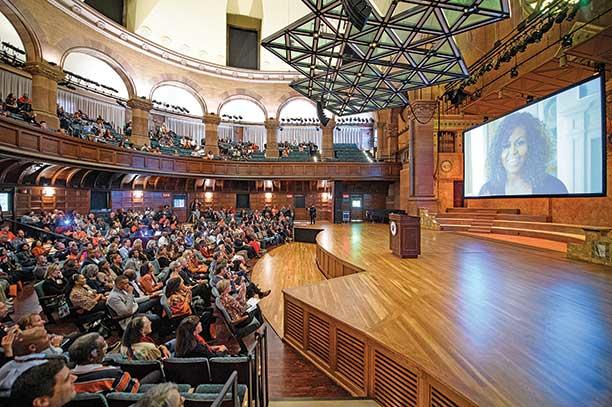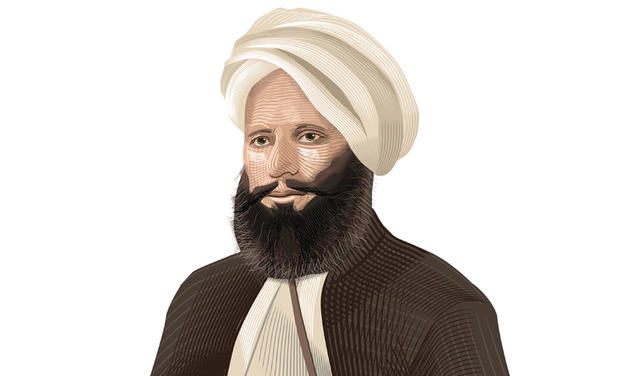Thrive Conference: ‘This is Our Reunions’
During the three-day conference, Princeton’s black community reflected on highs and lows

Moments of laughter, joy, reflection, and pain punctuated Thrive: Empowering and Celebrating Princeton’s Black Alumni, a conference on campus Oct. 3–5. The gathering featured educational sessions, thought-provoking dialogue, and opportunities for black alumni to connect across generations.
More than 1,200 participants attended the event, the University’s fourth conference for black alumni. Although they hail from different classes, many bonded over their shared experiences — some difficult — of being black at Princeton. Still, most alumni proudly donned orange hats, pants, nail polish, and sneakers.
As Franne McNeal ’82 put it, “This is our Reunions.”
“I’m thrilled to be here with all of you,” said Karen Richardson ’93, who started a career in admissions as a work-study undergrad and became dean of Princeton admission in July. “Welcome back, my friends.” She encouraged the alumni not only to reflect on their time at Princeton, but to pay it forward by connecting with current students.
President Eisgruber ’83 updated attendees on some of the projects and initiatives taking place at the University. Michael S. Fletcher II ’03, president of the Association of Black Princeton Alumni, said he was heartened by “how many people are coming back for the first time and how many are returning to continue your journey through Princeton.”
Even former first lady Michelle Obama ’85 surprised conference-goers with a pre-taped welcome message that was introduced by her brother, Craig Robinson ’83. “If there’s one thing that I’ve learned since I’ve left Princeton, it’s this: No matter what direction you’re headed, nobody gets there alone,” she said. “We all need to help each other to sharpen our skills and soften our landings or jump-start a change for the better. That’s how we can not only make progress for ourselves, but continue along the journey of discovering who we are. And that, to me, is what it means to thrive.”
The packed schedule included more than 200 participants in more than 60 events on topics that ranged from entrepreneurship and sports to media representation and history. Alumni also scheduled time to party — including a reunion of Selwyn Seyfu Hinds ’93, Mark Hines ’94, John Weaver ’92, and Dale Williams ’93, aka the FOPO DJs (short for Four Poor DJs), who mixed music for various campus organizations in the ’90s and had their own student radio show.
At one talk, Eddie S. Glaude Jr. *97, chair of African American studies, thanked the alumni for their impact in establishing the department. “Five years ago, we didn’t have a Department of African American Studies ... and in a short period of time, we have become the No. 1 Department of African American Studies in the country,” Glaude said as the crowd applauded heartily. He added, “What you’ve done, what you continue to do, what you went through — let’s be very clear — what you went through, paved the way for us to be what we are today.”
But Glaude, who read from his forthcoming book about James Baldwin, made clear that much work remains to be done — both at the national level and at Princeton itself. “As you see this place transformed — don’t believe it. We have a long way to go,” he said. “Princeton stands on the precipice of profound change,” he continued. “We must push it to tell a different story of itself — one that expresses your presence. Princeton desperately needs you to help it become what it aspires to be.”
The complex history of African Americans on Princeton’s campus was a recurring theme throughout the conference. During a panel on the Princeton & Slavery Project, history professor Martha Sandweiss detailed some of her research project’s findings, including that the first nine presidents of the college were slave owners and some slaves lived in the President’s House.
“I imagine that for generations of students, the first person they met on campus was the enslaved person who answered [their] knock,” Sandweiss said of a student’s first time arriving at the President’s House. “So if Nassau Hall and its stories of American freedom formed the backdrop of this campus, slavery was sometimes its very face.”
“We must push [Princeton] to tell a different story of itself — one that expresses your presence.”
— Eddie Glaude Jr. *97, chair of African American studies
During the question-and-answer period, an audience member asked whether the University has considered reparations. In response, Michele Minter, vice provost for institutional equity and diversity, said: “This is a topic we are in deep national conversation about — what reparations mean to us. What we know right now at Princeton ...[is] we have obligations to be of service and to the public good, and those obligations are informed by what we know and telling a more honest version of our history.” At the next day’s dedication of the Double Sights sculpture, which addresses the legacy of Woodrow Wilson 1879, the University’s efforts to reckon with its history were likewise called into question. (See On The Campus, page 13.)
Many conference-goers did not sugarcoat their experiences on Princeton’s campus. Still, alumni in attendance often voiced their pride to be part of Princeton’s approximately 5,800 black alumni.
“To me, Thrive represents progression in a series of conversations between the University and black students, and so I’ve appreciated that,” said Hilary Beard ’84. “It’s been important to me that the University has acknowledged and apologized for the harm that too many black students and students of color have experienced.”
For Kezia Otinkorang ’20, it was empowering to see so many successful black alumni. “Their joyful expressions, genuine interest in current students, and great faith in all of us meant the world to me and my peers. It gives us a glimpse into what black excellence and solidarity look like,” she said.
While the experience comes with peaks and valleys, Princeton gives students an opportunity to change their lives, said U.S. Rep. Terri Sewell ’86 of Alabama during her remarks at Thrive’s closing event. “While we all have individual successes, and all of us do, we collectively thrive because of our strength in numbers and our strength in support.”












3 Responses
Edith Wolff ’83
5 Years AgoRewarding Encounters
“Celebrating Black Alumni” (cover story, Nov. 13) made me think of my own many encounters with black students (now long-time alumni) at Princeton. Those started, on day one, with my RA. He was wonderful, and there were two other young black men in our entryway; all the rest of us were white women. My RA and his friends opened my eyes to so many aspects of the black experience in the United States, and taught me a new way of understanding our country’s history. Through many conversations, sitting around the dorm rooms late into the night, my eyes were opened, and these young men were wonderfully patient and caring as we talked over a huge variety of issues. Also, my RA used to play Billie Holiday records in his room — that was the first time I had ever heard her — and other jazz greats.
During the spring semester of my sophomore year, I was down at Dodge-Osborn. One person would put his record player right by the window, and blast, at full volume, his recordings of the speeches of Malcolm X for hours on end! I had never heard those speeches before, but I became very familiar with them, for which I am grateful to this day.
When I think about these kinds of memories, I feel so fortunate to have encountered students like those. The environment was changing then — black students were relatively new, women were still new, and the campus was changing. It was a rich time to be there, and I still feel grateful and lucky.
Norman Ravitch *62
5 Years AgoIdentity Politics?
Do we celebrate German-American alumni? Hebrew-American alumni? Irish-American alumni? Etc. Why is the Weekly identifying itself with identity politics? I thought the Life of the Mind was the point of it all? Even Princeton needs to beware of too much political (and academic) correctness.
Peter Seldin ’76
5 Years AgoRevisiting a Sensitive Subject
In the PAW article on the conference of black alumni, I read the following quote with some interest: "It's been important to me that the University has acknowledged and apologized for the harm that too many black students and students of color have experienced."
Personally, I think that this subject begs for greater discussion. What was the "harm" that the black students experienced? Were these negative experiences academic, extra-curricular, social or all of the above? Have these experiences improved for more recent black students, compared to the experiences of black students in the 1970s and 1980s? What have been the unintended consequences of the University's efforts to increase diversity?
PAW might consider revisiting what is obviously a sensitive, but vitally important, subject.